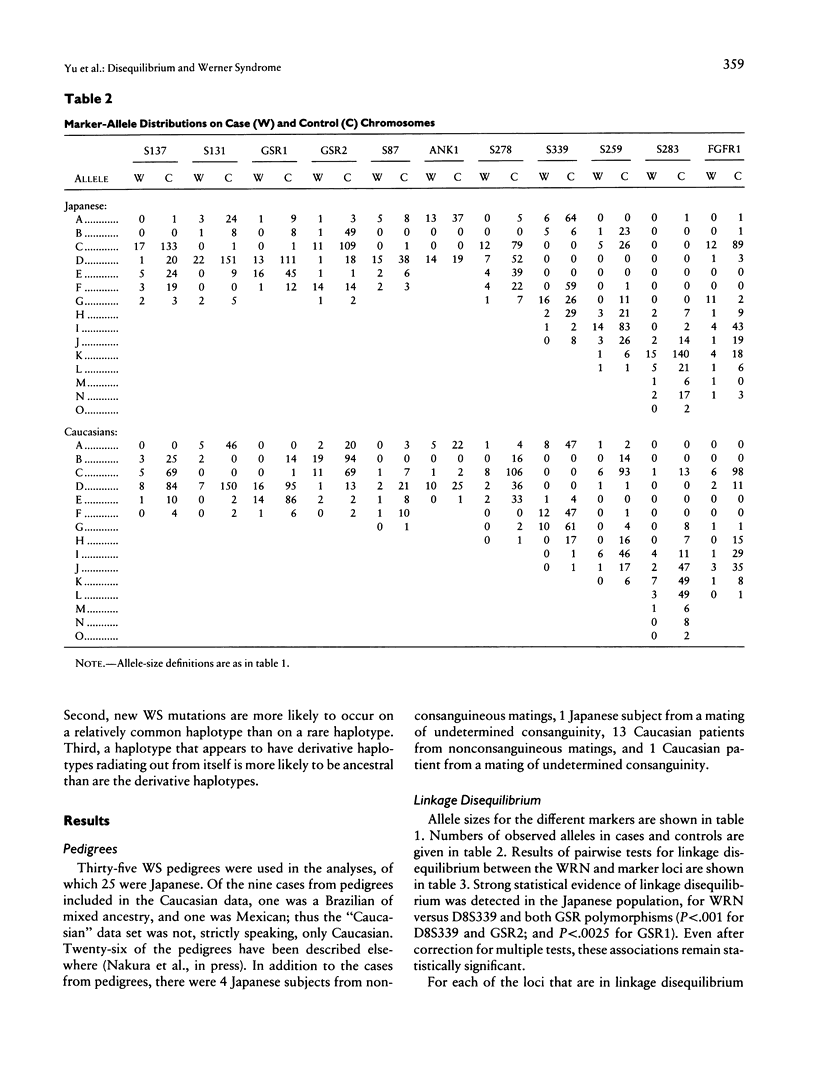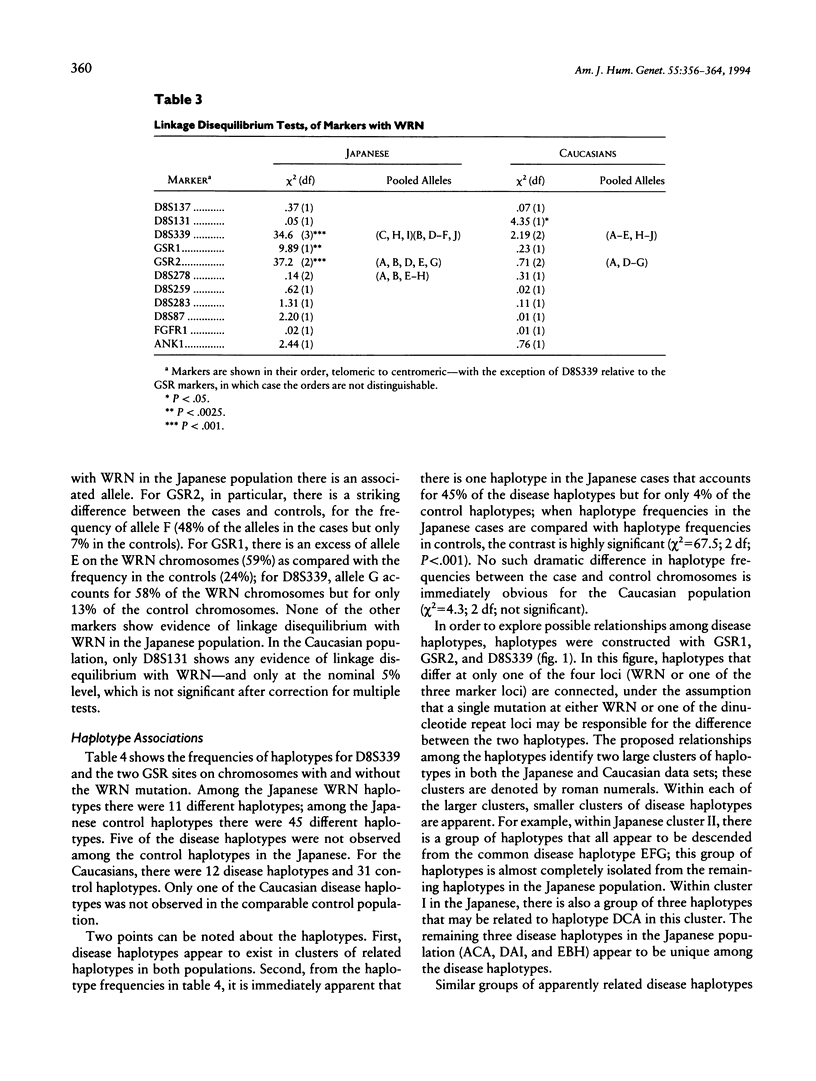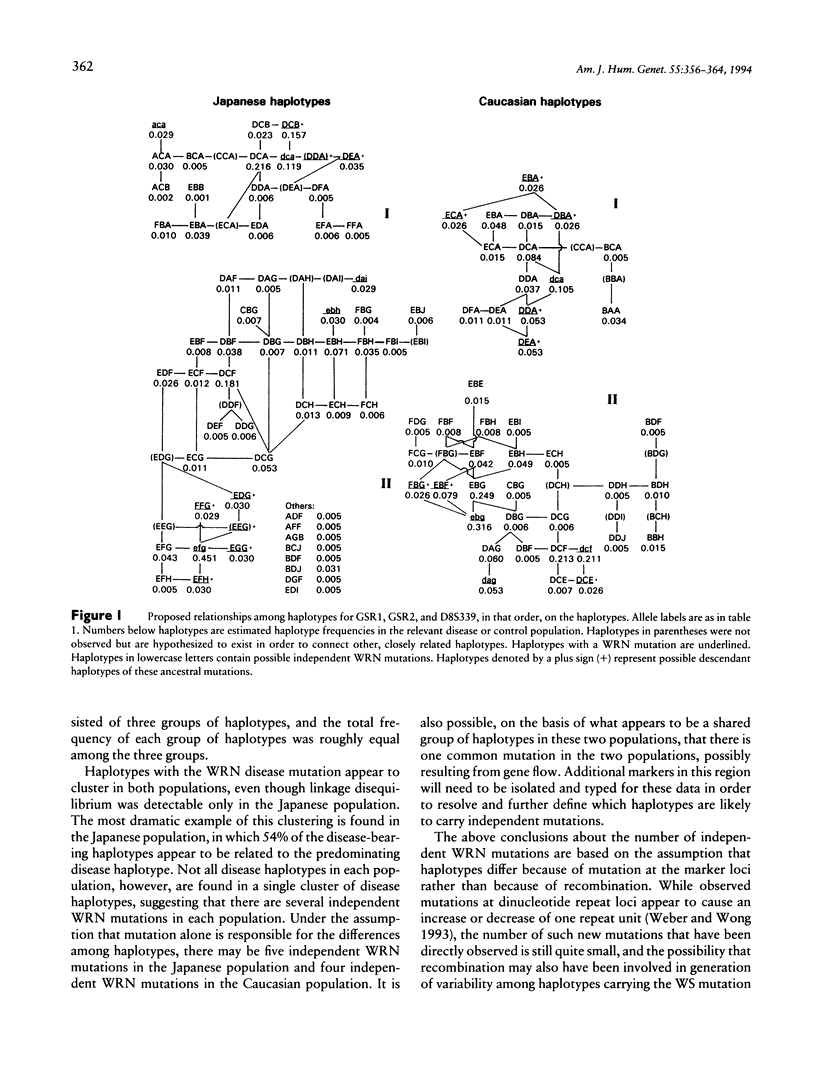Abstract
Werner syndrome (WS) is an autosomal recessive disorder, characterized as a progeroid syndrome, previously mapped to the 8p 11.1-21.1 region. Because WS is so rare, and because many patients are from consanguineous marriages, fine localization of the gene by traditional meiotic mapping methods is unlikely to succeed. Here we present the results of a search for a region that exhibits linkage disequilibrium with the disorder, under the assumption that identification of such a region may provide an alternative method of narrowing down the location of WRN, the gene responsible for WS. We present allele frequencies in Japanese and Caucasian cases and controls for D8S137, D8S131, D8S87, D8S278, D8S259, D8S283, fibroblast growth factor receptor 1, ankyrin 1, D8S339, and two polymorphisms in glutathione reductase (GSR), covering ∼16.5 cM in total. We show that three of the markers examined—D8S339 and both polymorphisms in the GSR locus—show strong statistically significant evidence of disequilibrium with WRN in the Japanese population but not in the Caucasian population. In addition, we show that a limited number of haplotypes are associated with the disease in both populations and that these haplotypes define clusters of apparently related haplotypes that may identify as many as eight or nine independent WRN mutations in these two populations.
Full text
PDF








Selected References
These references are in PubMed. This may not be the complete list of references from this article.
- Aksentijevich I., Pras E., Gruberg L., Shen Y., Holman K., Helling S., Prosen L., Sutherland G. R., Richards R. I., Dean M. Familial Mediterranean fever (FMF) in Moroccan Jews: demonstration of a founder effect by extended haplotype analysis. Am J Hum Genet. 1993 Sep;53(3):644–651. [PMC free article] [PubMed] [Google Scholar]
- Bull P. C., Thomas G. R., Rommens J. M., Forbes J. R., Cox D. W. The Wilson disease gene is a putative copper transporting P-type ATPase similar to the Menkes gene. Nat Genet. 1993 Dec;5(4):327–337. doi: 10.1038/ng1293-327. [DOI] [PubMed] [Google Scholar]
- CEPPELLINI R., SINISCALCO M., SMITH C. A. The estimation of gene frequencies in a random-mating population. Ann Hum Genet. 1955 Oct;20(2):97–115. doi: 10.1111/j.1469-1809.1955.tb01360.x. [DOI] [PubMed] [Google Scholar]
- Chakraborty R., Lidsky A. S., Daiger S. P., Güttler F., Sullivan S., Dilella A. G., Woo S. L. Polymorphic DNA haplotypes at the human phenylalanine hydroxylase locus and their relationship with phenylketonuria. Hum Genet. 1987 May;76(1):40–46. doi: 10.1007/BF00283048. [DOI] [PubMed] [Google Scholar]
- Epstein C. J., Martin G. M., Schultz A. L., Motulsky A. G. Werner's syndrome a review of its symptomatology, natural history, pathologic features, genetics and relationship to the natural aging process. Medicine (Baltimore) 1966 May;45(3):177–221. doi: 10.1097/00005792-196605000-00001. [DOI] [PubMed] [Google Scholar]
- Fujita R., Hanauer A., Sirugo G., Heilig R., Mandel J. L. Additional polymorphisms at marker loci D9S5 and D9S15 generate extended haplotypes in linkage disequilibrium with Friedreich ataxia. Proc Natl Acad Sci U S A. 1990 Mar;87(5):1796–1800. doi: 10.1073/pnas.87.5.1796. [DOI] [PMC free article] [PubMed] [Google Scholar]
- Goto M., Rubenstein M., Weber J., Woods K., Drayna D. Genetic linkage of Werner's syndrome to five markers on chromosome 8. Nature. 1992 Feb 20;355(6362):735–738. doi: 10.1038/355735a0. [DOI] [PubMed] [Google Scholar]
- Goto M., Takeuchi F., Tanimoto K., Miyamoto T. Clinical, demographic, and genetic aspects of the Werner syndrome in Japan. Adv Exp Med Biol. 1985;190:245–261. doi: 10.1007/978-1-4684-7853-2_11. [DOI] [PubMed] [Google Scholar]
- Harley H. G., Brook J. D., Floyd J., Rundle S. A., Crow S., Walsh K. V., Thibault M. C., Harper P. S., Shaw D. J. Detection of linkage disequilibrium between the myotonic dystrophy locus and a new polymorphic DNA marker. Am J Hum Genet. 1991 Jul;49(1):68–75. [PMC free article] [PubMed] [Google Scholar]
- Kerem B., Rommens J. M., Buchanan J. A., Markiewicz D., Cox T. K., Chakravarti A., Buchwald M., Tsui L. C. Identification of the cystic fibrosis gene: genetic analysis. Science. 1989 Sep 8;245(4922):1073–1080. doi: 10.1126/science.2570460. [DOI] [PubMed] [Google Scholar]
- Lander E. S., Botstein D. Homozygosity mapping: a way to map human recessive traits with the DNA of inbred children. Science. 1987 Jun 19;236(4808):1567–1570. doi: 10.1126/science.2884728. [DOI] [PubMed] [Google Scholar]
- Levinson G., Gutman G. A. Slipped-strand mispairing: a major mechanism for DNA sequence evolution. Mol Biol Evol. 1987 May;4(3):203–221. doi: 10.1093/oxfordjournals.molbev.a040442. [DOI] [PubMed] [Google Scholar]
- MacDonald M. E., Novelletto A., Lin C., Tagle D., Barnes G., Bates G., Taylor S., Allitto B., Altherr M., Myers R. The Huntington's disease candidate region exhibits many different haplotypes. Nat Genet. 1992 May;1(2):99–103. doi: 10.1038/ng0592-99. [DOI] [PubMed] [Google Scholar]
- Martin G. M. Genetic syndromes in man with potential relevance to the pathobiology of aging. Birth Defects Orig Artic Ser. 1978;14(1):5–39. [PubMed] [Google Scholar]
- Martin G. M., Sprague C. A., Epstein C. J. Replicative life-span of cultivated human cells. Effects of donor's age, tissue, and genotype. Lab Invest. 1970 Jul;23(1):86–92. [PubMed] [Google Scholar]
- Mitchison H. M., Thompson A. D., Mulley J. C., Kozman H. M., Richards R. I., Callen D. F., Stallings R. L., Doggett N. A., Attwood J., McKay T. R. Fine genetic mapping of the Batten disease locus (CLN3) by haplotype analysis and demonstration of allelic association with chromosome 16p microsatellite loci. Genomics. 1993 May;16(2):455–460. doi: 10.1006/geno.1993.1210. [DOI] [PubMed] [Google Scholar]
- Petrukhin K., Fischer S. G., Pirastu M., Tanzi R. E., Chernov I., Devoto M., Brzustowicz L. M., Cayanis E., Vitale E., Russo J. J. Mapping, cloning and genetic characterization of the region containing the Wilson disease gene. Nat Genet. 1993 Dec;5(4):338–343. doi: 10.1038/ng1293-338. [DOI] [PubMed] [Google Scholar]
- Schellenberg G. D., Martin G. M., Wijsman E. M., Nakura J., Miki T., Ogihara T. Homozygosity mapping and Werner's syndrome. Lancet. 1992 Apr 18;339(8799):1002–1002. doi: 10.1016/0140-6736(92)91590-5. [DOI] [PubMed] [Google Scholar]
- Tanzi R. E., Petrukhin K., Chernov I., Pellequer J. L., Wasco W., Ross B., Romano D. M., Parano E., Pavone L., Brzustowicz L. M. The Wilson disease gene is a copper transporting ATPase with homology to the Menkes disease gene. Nat Genet. 1993 Dec;5(4):344–350. doi: 10.1038/ng1293-344. [DOI] [PubMed] [Google Scholar]
- Thomas W., Drayna D. A polymorphic dinucleotide repeat at the D8S339 locus. Hum Mol Genet. 1993 Jun;2(6):828–828. doi: 10.1093/hmg/2.6.828. [DOI] [PubMed] [Google Scholar]
- Thomas W., Rubenstein M., Goto M., Drayna D. A genetic analysis of the Werner syndrome region on human chromosome 8p. Genomics. 1993 Jun;16(3):685–690. doi: 10.1006/geno.1993.1248. [DOI] [PubMed] [Google Scholar]
- Tomfohrde J., Wood S., Schertzer M., Wagner M. J., Wells D. E., Parrish J., Sadler L. A., Blanton S. H., Daiger S. P., Wang Z. Human chromosome 8 linkage map based on short tandem repeat polymorphisms: effect of genotyping errors. Genomics. 1992 Sep;14(1):144–152. doi: 10.1016/s0888-7543(05)80297-6. [DOI] [PubMed] [Google Scholar]
- Weber J. L., May P. E. Abundant class of human DNA polymorphisms which can be typed using the polymerase chain reaction. Am J Hum Genet. 1989 Mar;44(3):388–396. [PMC free article] [PubMed] [Google Scholar]
- Weber J. L., Wong C. Mutation of human short tandem repeats. Hum Mol Genet. 1993 Aug;2(8):1123–1128. doi: 10.1093/hmg/2.8.1123. [DOI] [PubMed] [Google Scholar]
- Weissenbach J., Gyapay G., Dib C., Vignal A., Morissette J., Millasseau P., Vaysseix G., Lathrop M. A second-generation linkage map of the human genome. Nature. 1992 Oct 29;359(6398):794–801. doi: 10.1038/359794a0. [DOI] [PubMed] [Google Scholar]
- Yu C. E., Anderson L., Oshima J., Schellenberg G. D. Dinucleotide repeat polymorphism at the D8S131 locus. Hum Mol Genet. 1994 Jan;3(1):211–211. [PubMed] [Google Scholar]


